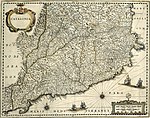
Back Guerra dels remences Catalan Guerras remensas Spanish Guerra de los Remensas Dutch Guerras Remensas Portuguese Война де лос Ременсас Russian
You can help expand this article with text translated from the corresponding article in Catalan. (June 2017) Click [show] for important translation instructions.
|
| History of Catalonia |
|---|
 |
| Timeline |
The Rebellion of the Remences or War of the Remences was a popular revolt in late medieval Europe against seignorial pressures that began in the Principality of Catalonia in 1462 and ended a decade later without definitive result. Ferdinand II of Aragon finally resolved the conflict with the Sentencia Arbitral de Guadalupe in 1486.[1]
The Catalan term remença derives from the Latin redementia and emphasizes the possibility of redemption from servitude.[2]
In the early 14th century, the rise of Catalan cities and the expansion of Catalan culture and the Aragonese Empire led to a decline in the rural population, which declined still further due to the Black Death. The nobility began to strictly enforce the evil customs tying peasants to the land; they also began a much stricter enforcement of seignorial rights in general than had been the practice in recent centuries.
The strongest support for open rebellion came from the poorest peasants. Those with more goods—who were in the majority on the Plain of Vic, l'Empordà, and el Vallès—tried to appeal to the king for reforms and the end of the seignorial abuses. The monarchy had some reasons to wish to have the peasants as an independent force, since the Aragonese crown was continually in a power struggle with the nobility.
In the mid-15th century, Alfonso V of Aragon, "the Magnanimous", allowed the peasants to form a sindicat remença, a peasants' guild or primitive trade union, granted them their liberty and intervened in several other ways against the abuses. However, the Bishop of Girona sided with the nobility; along with the Generalitat, controlled by the nobles, their opposition led Alfonso to reverse himself.
Alfonso's successor, John II, sought the peasants' help against the nobility. By May 1461, the peasantry had declared themselves in favor of the king against the nobles.
- ^ Freedman, Paul (January 22, 2004). The Origins of Peasant Servitude in Medieval Catalonia. Cambridge University Press. pp. 210–211. ISBN 978-0-521-54805-2. OCLC 1002169373.
- ^ [1] Archived August 10, 2004, at the Wayback Machine